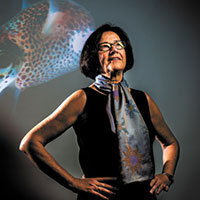Prof. Dr. Margaret McFall-Ngai (University of Hawaii at Manoa)
Invited guest speaker at the Biology Center of the Christian-Albrechts-University Kiel
Monday, October 22nd 2018, 16:15
ZMB
Conference room 4th floor
Am Botanischen Garten 11
As guest of the CRC 1182
Prof. Dr. Margaret McFall-Ngai
University of Hawaii at Manoa
Talks about:
“Making your presence known: Systemic effects of symbiont colonization”
Abstract:
Recent studies of animal and plant microbiomes have demonstrated that they can have far reaching effects, influencing both the internal and external environments of the host. For example, the human microbiome impacts both tissues with which it directly interacts and more remote tissues of the body, as well as the built and natural environment in which the human host resides. These complex microbial networks profoundly influence host development, from embryogenesis through senescence, while maintaining physiological homeostasis along this trajectory.
The best-studied nexus of these complex interactions is the mammalian gut microbiome, which affects not only the gut tissues themselves, but also the immune system, brain, liver, heart, kidney, lung, and eye. The microbiome also helps coordinate the activities of these tissues and organs, e.g., the strong association of the gut microbiota with the control of host circadian rhythms. Further, axes of influence between the gut and other organs have revealed that dysbiosis of the microbiome is a critical driver of seemingly unrelated diseases.
What are the dominant features of the symbiosis that are driving these effects? For example, are they due to the direct or indirect influences of the microbes and their products (e.g., MAMPs, SCFAs); are they a reflection of the dependence of the host on the microbiome for aspects of host nutrition; or combinations of these and other factors?
This presentation highlights research for which a model organism was used to provide insight into these questions. The symbiosis between the Hawaiian squid Euprymna scolopes and its luminous bacterial partner Vibrio fischeri has two features that render it a powerful experimental system for these analyses. First, unlike many symbioses where the host harbors dozens to thousands of symbiotic partners, the squid-vibrio association is a naturally occurring binary association. As such, any observed effects of wild-type or mutant symbionts on tissues remote from the site of colonization are unequivocally due to the influence of V. fischeri. Second, the host benefits from the symbiont’s light production, used by the night-active host in its camouflaging; unlike the case in nutritional symbioses, the lack of luminous symbionts under laboratory conditions does not compromise the physiology of the host. Thus, colonization of host tissues by a population of symbionts can be studied independently of nutrition. Using experimental manipulation of the symbiosis, symbiont genetics, and host transcriptomics, we find that despite the fact that the symbiont population is highly localized, it has profound effects on the molecular biology and biochemistry of remote tissues in ways that demonstrate the power of the principal function of a symbiotic partnership.
Who
When
October 22nd, 2018
16:15
Where
Conference room 4th floor





